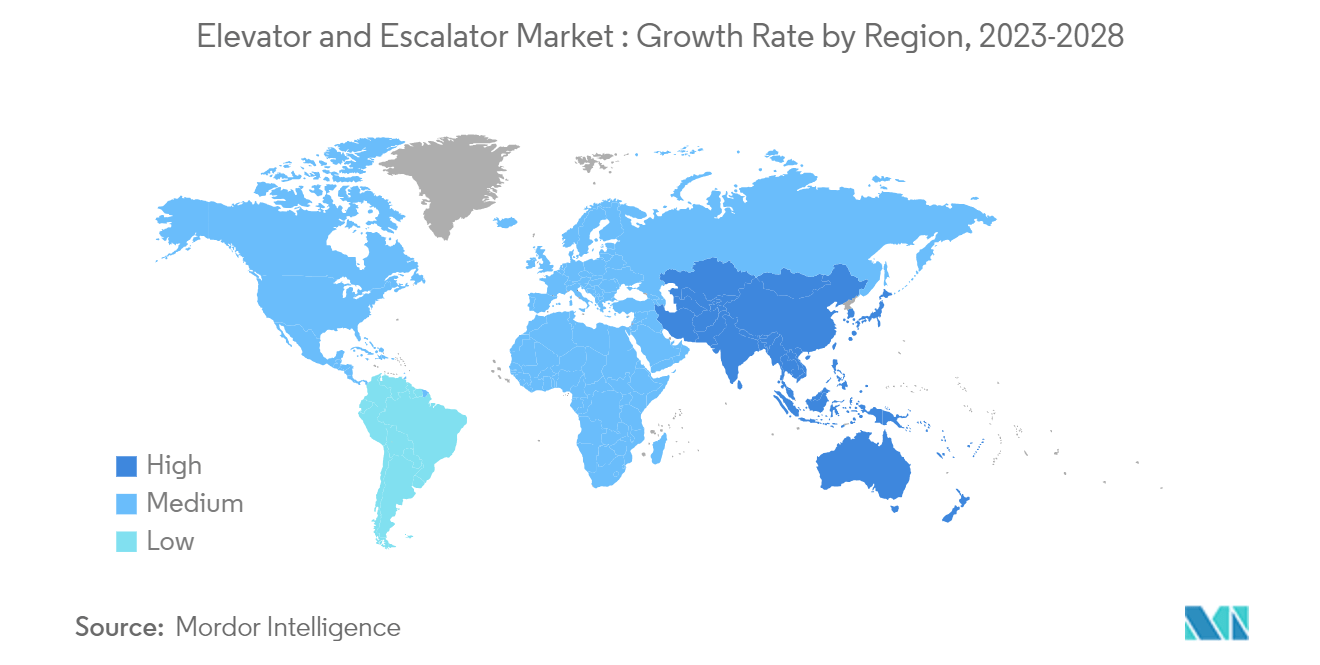Market Trends of Elevator and Escalator Industry
Rising Investments in Public Infrastructure Projects to Drive the Market
- Globally, rising investments in infrastructure projects to cater to the demands of growing populations and living standards are expected to be one of the most significant drivers for market growth during the forecast period.
- The ongoing trend of urbanization is leading to the rapid growth of cities worldwide. As cities expand vertically with more high-rise buildings, the demand for efficient vertical transportation solutions, such as elevators and escalators, becomes crucial to ensure seamless floor mobility. These transportation systems are pivotal in addressing congestion and optimizing space utilization.
- Governments worldwide prioritize developing robust public infrastructure to support economic growth and cater to the needs of a growing population. Investments are being made in various projects, including transportation hubs, commercial complexes, airports, and railway stations. As a result, the demand for elevators and escalators in these large-scale logistical and commercial hubs is steadily rising, as these mobility solutions are essential components facilitating the easy movement of people and goods.
- As concerns about greenhouse emissions have intensified globally, the demand for sustainable infrastructure has grown. To reach the sustainable development goals by 2030 and achieve net zero emissions by 2050, substantial funding must be directed toward sustainable and resilient infrastructure. According to the Organisation for Economic Co-operation and Development (OECD), an estimated USD 6.9 trillion annually is required until 2050 to invest in infrastructure, enabling the fulfillment of development objectives and the creation of a low-carbon, climate-resilient future.
- According to the Global Infrastructure Hub, as of 2023, a considerable gap exists in required investments, amounting to trillions of dollars. As concerns about emissions grow and investments are made in developing new sustainable infrastructure, this is expected to create a rapid demand for elevators and escalators during the forecast period.
- Hence, investments in new sustainable infrastructure are expected to drive the growth of the market during the forecast period.

Asia-Pacific to be the Fastest-growing Market Segment
- The Asia-Pacific region is witnessing rapid urbanization, population growth, and increased infrastructural development, leading to a surge in the demand for elevators and escalators. The Asia-Pacific region has been experiencing significant urbanization as rural populations migrate to cities for better economic opportunities and improved living standards. The concentration of populations in urban centers has resulted in the construction of high-rise buildings and commercial spaces, thereby amplifying the need for vertical transportation solutions.
- Several countries in the Asia-Pacific region are investing heavily in infrastructural development to boost economic growth and address urban challenges. Governments are undertaking ambitious mega projects, such as new airports, railway networks, and smart cities, which invariably require vertical transportation solutions.
- China, India, and Japan, particularly, are witnessing substantial infrastructural investments. China has been the largest market for elevators and escalators globally, owing to its massive urbanization initiatives and high-rise building constructions. India's rapid urbanization and infrastructure projects have also led to significant demand for elevators and escalators, especially in metropolitan cities.
- In India, during Budget 2023-24, the capital investment outlay for infrastructure is increasing by 33%, reaching INR 10 lakh crore (USD 122 billion), accounting for 3.3% of GDP. The Union Budget 2023-24 has allocated a record-breaking capital outlay of INR 2.40 lakh crore (USD 29 billion) for the Railways, representing a ninefold increase compared to the outlay in 2013-14.
- According to news reports, the National Infrastructure Pipeline (NIP) project count has expanded from 6,835 to 9,142, encompassing 34 sub-sectors. Within the initiative, 2,476 projects are currently in development, with an estimated investment of USD 1.9 trillion. Nearly half of the under-development projects are concentrated in the transportation sector, while 3,906 are in the roads and bridges sub-sector.
- For FY24, the Indian Railways anticipates achieving a total revenue from traffic amounting to INR 2,64,600 crore (USD 32.17 billion).
- In December 2022, the Airport Authority of India (AAI) and other Airport Developers set a target capital outlay of approximately INR 98,000 crore (USD 11.8 billion) for the airport sector over the next five years. This investment will be utilized to expand and modify existing terminals, construct new terminals, and strengthen runways, among other development activities.
- Hence, due to the rapid rise in urbanization and such significant infrastructure investments, especially in China and India, the Asia-Pacific region is expected to be the fastest-growing region in the market during the forecast period.


